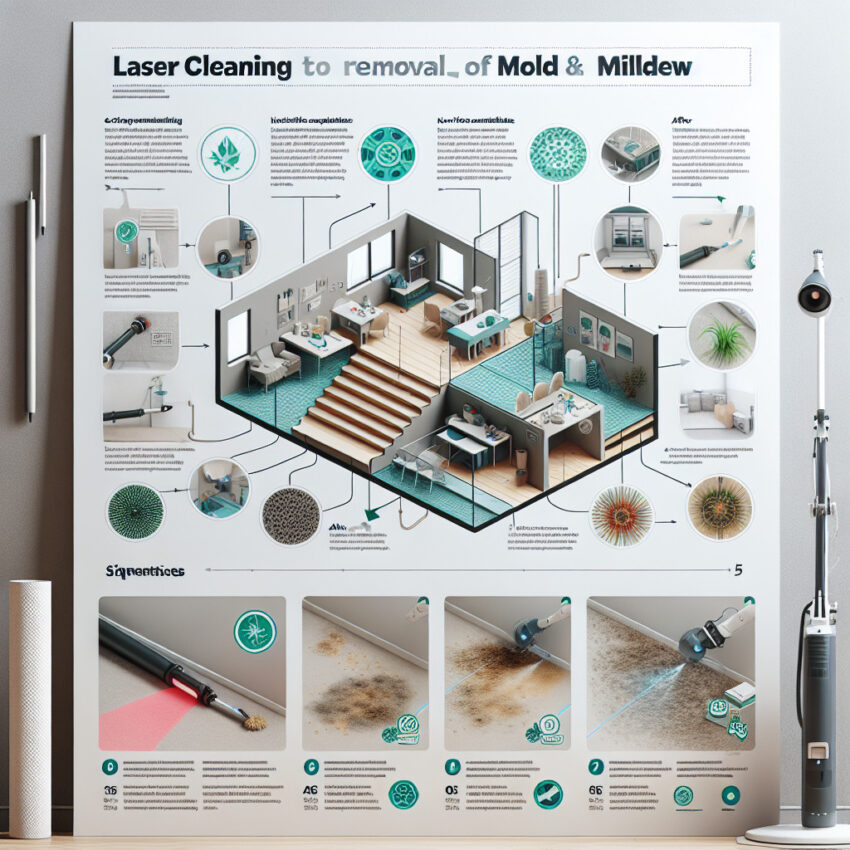- Benefits of Laser Cleaning for Mold and Mildew Removal
- How Laser Technology Works for Surface Cleaning
- Comparison of Laser Cleaning vs Traditional Methods for Mold Removal
- Safety Considerations for Laser Cleaning in Mold Removal
- Case Studies of Successful Mold and Mildew Removal with Laser Technology
Benefits of Laser Cleaning for Mold and Mildew Removal
How Does Laser Cleaning Work?
Laser cleaning uses a high-powered laser beam to remove contaminants from surfaces. The laser energy vaporizes the mold and mildew, leaving behind a clean surface. Unlike traditional cleaning methods, laser cleaning does not require the use of chemicals or abrasive materials. This makes it a safe and environmentally friendly option for mold and mildew removal.
Benefits of Laser Cleaning for Mold and Mildew Removal
- Safe and Environmentally Friendly: Laser cleaning does not involve the use of harsh chemicals that can be harmful to people and the environment. It is a safe and eco-friendly method for removing mold and mildew.
- Effective: Laser cleaning is highly effective at removing mold and mildew from surfaces. The high-powered laser beam can penetrate deep into porous materials to eliminate contaminants.
- Precision: Laser cleaning allows for precise control over the cleaning process. This ensures that only the mold and mildew are removed, leaving the underlying surface intact.
- No Residue: Unlike traditional cleaning methods, laser cleaning does not leave behind any residue. This helps to prevent the regrowth of mold and mildew on treated surfaces.
- Time and Cost Savings: Laser cleaning is a fast and efficient method for removing mold and mildew. It can save time and money compared to traditional cleaning methods that require multiple steps and products.
- Versatile: Laser cleaning can be used on a variety of surfaces, including wood, metal, concrete, and more. It is a versatile solution for mold and mildew removal in different environments.
Conclusion
Laser cleaning offers many benefits for mold and mildew removal. It is a safe, effective, and environmentally friendly method that can save time and money. With its precision and versatility, laser cleaning is a great option for removing mold and mildew from surfaces in homes and buildings.
How Laser Technology Works for Surface Cleaning
How Laser Cleaning Works
Laser cleaning works by using a high-energy laser beam to remove contaminants from a surface. The laser beam is focused on the surface, where it heats up and vaporizes the contaminants, leaving behind a clean surface. The process is non-contact, meaning that the laser beam does not physically touch the surface being cleaned, which helps to prevent any damage.
There are two main types of laser cleaning methods: ablation and non-ablation. Ablation cleaning involves removing the contaminants by vaporizing them, while non-ablation cleaning uses the laser beam to heat up the contaminants and cause them to break down and evaporate.
Benefits of Laser Cleaning
There are several benefits to using laser technology for surface cleaning. Some of the key advantages include:
| Advantages | Description |
|---|---|
| Non-contact | Laser cleaning is a non-contact process, which helps to prevent damage to the surface being cleaned. |
| Precision | Laser technology allows for precise control over the cleaning process, ensuring that only the contaminants are removed without affecting the underlying material. |
| Environmentally friendly | Laser cleaning does not require the use of harsh chemicals or abrasive materials, making it a more environmentally friendly option. |
| Efficiency | Laser cleaning is a fast and efficient process, allowing for quick and thorough cleaning of surfaces. |
Applications of Laser Cleaning
Laser cleaning technology has a wide range of applications across various industries. Some common applications include:
| Industry | Application |
|---|---|
| Automotive | Removing paint and rust from metal surfaces |
| Manufacturing | Cleaning molds and tooling |
| Historical preservation | Restoring delicate artifacts and monuments |
| Electronics | Cleaning circuit boards and components |
Conclusion
Laser technology offers a precise, efficient, and environmentally friendly way to clean surfaces without causing any damage. The non-contact nature of laser cleaning makes it ideal for delicate materials and intricate surfaces. With its wide range of applications across various industries, laser cleaning is becoming an increasingly popular choice for surface cleaning. As technology continues to advance, we can expect to see even more innovative uses for laser cleaning in the future.
Comparison of Laser Cleaning vs Traditional Methods for Mold Removal
Traditional Methods
Traditional methods of mold removal typically involve the use of chemical cleaners, scrubbing brushes, and other tools to physically remove the mold from surfaces. While these methods can be effective, they often require a significant amount of time and effort to complete. Additionally, the use of harsh chemicals can pose a risk to both the environment and human health.
Laser Cleaning
Laser cleaning is a non-contact method of mold removal that uses high-intensity laser beams to vaporize mold and other contaminants from surfaces. This method is highly effective at removing mold without the need for harsh chemicals or manual labor. Laser cleaning is also environmentally friendly, as it does not produce any harmful byproducts or waste.
Comparison
| Aspect | Traditional Methods | Laser Cleaning |
|---|---|---|
| Effectiveness | Effective, but may require multiple treatments | Highly effective, usually requires only one treatment |
| Time | Time-consuming | Quick and efficient |
| Environmental Impact | Can be harmful to the environment | Environmentally friendly |
| Health Risks | Potential health risks from exposure to chemicals | No health risks |
Conclusion
In conclusion, laser cleaning offers a more efficient and environmentally friendly alternative to traditional methods of mold removal. While traditional methods can be effective, they often require a significant amount of time and effort to complete, and can pose risks to both the environment and human health. Laser cleaning, on the other hand, is highly effective at removing mold without the need for harsh chemicals or manual labor, and is environmentally friendly. Overall, laser cleaning is a superior method for mold removal in terms of effectiveness, efficiency, and environmental impact.
Safety Considerations for Laser Cleaning in Mold Removal
Eye Protection
One of the most important safety considerations when using lasers for mold removal is eye protection. Laser beams can cause serious damage to the eyes if proper precautions are not taken. It is essential to wear appropriate laser safety goggles that are designed to protect against the specific wavelength of the laser being used.
Skin Protection
In addition to eye protection, it is also important to protect the skin from exposure to laser beams. Laser beams can cause burns and other skin damage if they come into direct contact with the skin. It is recommended to wear long sleeves, gloves, and other protective clothing when using lasers for mold removal.
Ventilation
Another important safety consideration is ventilation. Laser cleaning can produce fumes and particles that may be harmful if inhaled. It is important to ensure that the work area is well-ventilated to prevent the buildup of fumes and particles. Additionally, it is recommended to wear a respirator to protect against inhaling any harmful substances.
Fire Safety
Laser beams can generate heat and sparks, which can pose a fire hazard. It is important to take precautions to prevent fires when using lasers for mold removal. This may include keeping flammable materials away from the work area, having a fire extinguisher on hand, and following proper safety protocols.
Training
Proper training is essential when using lasers for mold removal. It is important to be familiar with the equipment and safety procedures before using lasers for mold removal. Training should cover how to safely operate the laser, how to protect oneself from potential hazards, and what to do in case of an emergency.
Conclusion
When using lasers for mold removal, it is important to prioritize safety. By following the safety considerations outlined in this article, you can help ensure a safe and effective mold removal process. Remember to always wear appropriate eye and skin protection, ensure proper ventilation, take fire safety precautions, and undergo proper training before using lasers for mold removal.
Case Studies of Successful Mold and Mildew Removal with Laser Technology
Here are some case studies of successful mold and mildew removal using laser technology:
Case Study 1: Residential Home
A family in a residential home noticed mold and mildew growth in their basement. They tried using traditional cleaning methods, but the mold kept coming back. They decided to hire a professional mold removal company that used laser technology for the job.
The laser technology was able to target and destroy the mold and mildew at the source, without causing any damage to the surrounding surfaces. The process was quick, efficient, and the family was able to return to their home within a few hours. The mold did not return, and the family was able to enjoy a clean and healthy living environment.
Key Takeaways:
– Laser technology is effective at removing mold and mildew at the source
– The process is quick and efficient
– The mold did not return after treatment
Case Study 2: Commercial Building
A commercial building owner noticed mold and mildew growth in the bathrooms of their building. They were concerned about the health and safety of their employees and customers, so they contacted a mold removal company that specialized in laser technology.
The laser technology was able to target and remove the mold and mildew without causing any disruption to the daily operations of the building. The process was completed quickly, and the bathrooms were left clean and mold-free. The building owner was impressed with the results and decided to use laser technology for future mold and mildew removal needs.
Key Takeaways:
– Laser technology can be used in commercial settings without disrupting daily operations
– The process is quick and effective
– Building owners can trust laser technology for future mold and mildew removal needs
Case Study 3: Historical Building
A historical building with mold and mildew issues needed a delicate and non-invasive solution for removal. Traditional methods were not suitable for the building’s fragile surfaces, so the owners turned to laser technology for help.
The laser technology was able to target and remove the mold and mildew without causing any damage to the historical building’s surfaces. The process was gentle yet effective, and the building was left clean and restored to its original state. The owners were thrilled with the results and praised the use of laser technology for mold and mildew removal.
Key Takeaways:
– Laser technology is gentle and non-invasive, making it suitable for historical buildings
– The process is effective at removing mold and mildew without causing damage
– Building owners can trust laser technology for delicate removal needs
In conclusion, these case studies demonstrate the effectiveness of laser technology for mold and mildew removal. Whether in residential homes, commercial buildings, or historical sites, laser technology offers a quick, efficient, and non-invasive solution for removing mold and mildew. Building owners and homeowners can trust in the power of laser technology to provide clean and healthy living and working environments.
- Sure! Here are some questions related to Mobile Apps Development and Maintenance: - 25 October 2025
- The role of a Software Development Company in healthcare technology - 29 September 2025
- Laser cleaning for removing mold and mildew from surfaces - 24 July 2024




